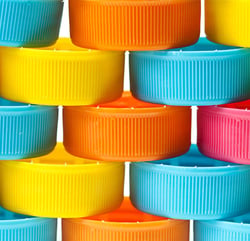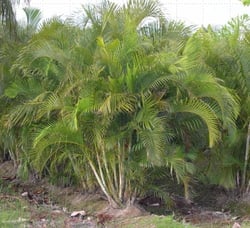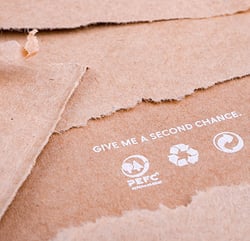
The sustainability of a product is affected by all the stages of its lifecycle, from the choice of raw materials and the production processes to the logistics and the end of its life. Understanding the sustainability of materials is key to all the different stages of the product lifecycle.
In this blog we touch on the sustainability of materials used in packaging. When it comes to sustainable disposables there is no ‘one-size-fits-all’ solution. Generally, there are two sides of the sustainability coin when it comes to packaging: what is it made of and what can you do with it after use.
Sustainable Packaging Materials: Renewable Resources
Renewable resources are materials that can be, well, renewed. This means that once you take some for use, more can easily be replenished. The plants grow at a rate that is comparable or faster than their rate of consumption. Like for example trees, corn-starch for bio-plastics, or crop by-products like sugarcane pulp – all sustainably grown and processed into packaging. By comparison, oil-based plastic is made from oil which is a finite resource – meaning, once we use the resource, there’s no getting it back. So, oil and other fossil fuels are limited. Examples of such renewable materials are:
Bio-plastics (PLA)
 These are plastics made from plant starch, specifically corn starch. The starch contained within the plant is processed to produce a polymer. Bio-plastics behave in a similar way to conventional plastics and are suitable for most packaging applications. However, unlike finite oil based plastics which take millions of years to form and hundreds of years to degrade, they are annually renewable and suitable for commercial or industrially produced compost within 12 weeks where facilities exist.
These are plastics made from plant starch, specifically corn starch. The starch contained within the plant is processed to produce a polymer. Bio-plastics behave in a similar way to conventional plastics and are suitable for most packaging applications. However, unlike finite oil based plastics which take millions of years to form and hundreds of years to degrade, they are annually renewable and suitable for commercial or industrially produced compost within 12 weeks where facilities exist.
Bagasse (Sugarcane)
The waste material produced once sugarcane has been harvested for the sugar syrup is called bagasse. This fibrous material is a renewable resource. It is made from a waste product therefore it reduces waste. Sugar bagasse is turned into packaging products from its raw form using a process of heating, pulping and then pressurised moulding. These products are compostable and 100% plastic free.
Areca Palm leaf

These products are natural, tough, heat resistant and compostable. Whole leaf products have no pulp or starch. It actually is just a leaf fallen from a tree that’s been washed and pressed into the desired shape. Once heat pressed (without chemicals, glue or anything else) the leaves become strong & durable. That is, until you compost them and they go right back into the soil.
Sustainable forest paper and wood
This card/paper or wood used comes from trees farmed from a responsibly managed forest, and can be used for a variety of applications such as cups, bio boxes, wrap containers, etc! The trees are replaced faster than they are consumed. Sustainable forest paper ensures that the forests from which the paper comes are managed to maintain forest integrity.
Sustainable Packaging Materials: Recycled Materials
Recycled materials are simply materials that have been used before and then used again – so not wasted to landfill or litter. After a product is used, depending on what type of plastic it is it might get down-cycled (recycled into a lower quality product) or up-cycled (recycled into the same product or one of equal quality). Examples of such materials are:
Recycled plastic (rPET)
 rPET (recycled polyethylene terephthalate) is the most common plastic that is being recycled back into primary revive bottles applications (i.e. bottles recycled back into bottles and not ‘down-cycled’ into lesser products like park furniture). Recycled plastics reduce the amount of fossil fuel resources, have a lower carbon footprint than virgin plastics, divert material from landfill and can themselves be recycled.
rPET (recycled polyethylene terephthalate) is the most common plastic that is being recycled back into primary revive bottles applications (i.e. bottles recycled back into bottles and not ‘down-cycled’ into lesser products like park furniture). Recycled plastics reduce the amount of fossil fuel resources, have a lower carbon footprint than virgin plastics, divert material from landfill and can themselves be recycled.
Recycled paper/card
These products contribute to the diversion of material from landfill and results less land being given over to commercial forestry which can have a negative impact on biodiversity. Sustainable forest paper ensures that the forests from which the paper comes are managed so as maintain forest integrity.
How can we improve the sustainability of packaging?
There are many different ways of ensuring the sustainability of a product when it comes to packaging.
Design for recycling
More recycling is, of course, a great development. But how can a net positive effect on the environment and the economy be enabled? In order to be recycled, post-consumer packaging has to fulfil a long list of requirements (e.g., seperability, cleanliness, labelling and coloration). Just because a packaging product is designed for recycling today, it does not automatically mean that it will be recycled. Choosing the right materials for the item and its packaging is the first step. Then it is important to educate stakeholders, through all the appropriate channels, on what they can do.
Design for reuse
.jpg?width=300&name=Canva%20-%20Selective%20Focus%20Photography%20of%20Green-leafed%20Plant%20(1).jpg) Reuse is more difficult to envision than recycling given the current mind-set. It requires moving away from the way packaging is handled at the moment. Furthermore, it also necessitates more robust and sustainable packaging materials that need to withstand washing and sterilization.
Reuse is more difficult to envision than recycling given the current mind-set. It requires moving away from the way packaging is handled at the moment. Furthermore, it also necessitates more robust and sustainable packaging materials that need to withstand washing and sterilization.
And let’s not forget that it needs to have a well-built infrastructure to collect, wash, sterilize, refill and return the packaging to consumers. Of course it should be taken into account that some materials might have a higher impact than their single-use alternatives, like for example the current version of a reusable PET bag. You would need to use the reusable bag at least 50 times to make it more sustainable. While increasing reuse is a must-win battle for optimizing resources and drastically reducing waste, companies need to use eco-design and life cycle thinking, and push for infrastructure of scale with a massive customer-base to make the transition truly environmentally sound.
Reduce and Remove Packaging
 Reducing and ultimately removing packaging from products is an effective way of minimizing the materials in circulation and ultimately the environmental impact of packaging. But we should not exclude the purpose of packaging when we assess its environmental impact. If the packaging fails to fulfil its primary purpose of safeguarding the product’s quality, the product may go to waste, and the environmental impact of a wasted product is, in general, far higher than that of the avoided packaging material.
Reducing and ultimately removing packaging from products is an effective way of minimizing the materials in circulation and ultimately the environmental impact of packaging. But we should not exclude the purpose of packaging when we assess its environmental impact. If the packaging fails to fulfil its primary purpose of safeguarding the product’s quality, the product may go to waste, and the environmental impact of a wasted product is, in general, far higher than that of the avoided packaging material.
ASL’s Approach
At ASL, we always take into consideration the product’s lifecycle sustainability. We work collaboratively with our clients to develop more sustainable marketing products which impact audiences, not the environment. Contact us to see how we can help you to create more sustainable packaging solutions for your campaigns.
ASL Global is committed to conducting our business in a responsible & sustainable way. Acting with passion and integrity, our people work with customers, suppliers and other stakeholders to make a positive contribution to social responsibility and environmental sustainability in communities around the world.

Discover more about our ONE WORLD initiative







